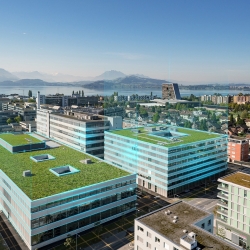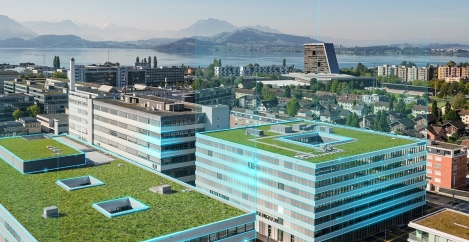April 20, 2021
Buildings with a digital twin have a lot to tell us
 The expression “if these walls could talk” is taking on an entirely new meaning with the emerging opportunity to create digital twins for buildings. Across the entire lifecycle of structures such as office buildings, hospitals, airports and hotels, creating a digital twin can significantly reduce costs, improve efficiencies, speed construction delivery, as well as enhance performance and the user experience.
The expression “if these walls could talk” is taking on an entirely new meaning with the emerging opportunity to create digital twins for buildings. Across the entire lifecycle of structures such as office buildings, hospitals, airports and hotels, creating a digital twin can significantly reduce costs, improve efficiencies, speed construction delivery, as well as enhance performance and the user experience.
The opportunities of how to apply the data from the twin are wide-ranging. We have demonstrated that during the design of any building the digital twin can help create safer evacuation routes and infrastructures. In a hospital, a building digital twin can help monitor not only the location of equipment but also of patients as they move through the building. For office building tenants and owners, a digital twin can provide real-time monitoring of the occupancy and use of building spaces to help reduce lighting and heating, ventilation and air conditioning (HVAC) costs, while providing insights for better use of space.
Digital twins are already in use in manufacturing and industrial settings, from automobile production to power plant operations. For buildings, the digital twin can play a crucial role in three areas of a building’s lifecycle: design, construction and operation.
In the design phase, the digital twin can capture all static data about a building, such as the size of the floor plate, number of rooms, windows, wiring, technologies installed across the building, and construction materials used. Through visualizations and simulations, the building design can be tweaked to include aspects such as evacuation planning, projected energy use and optimized room layouts.
In the construction phase, this information can speed up project execution, improve engineering efficiency and enable visualization, engineering, commissioning, simulation of system behavior, and artificial intelligence learning.
In the operational phase, the digital twin helps building operators and facilities managers improve operating efficiencies, unlock predictive maintenance, and make improvements that are informed by dynamic simulations. Data comes from sources throughout the structure, such as HVAC systems, boilers, and sensors. They monitor conditions such as temperature, humidity, occupancy, lighting, external weather, and fire detection.
[nbz-inline-newsletter]
Good for greenfield and brownfield
While so far I have been talking about new building construction, a digital twin can also be developed for existing buildings. However, there is a caveat. Such a building must have – or be retrofitted with – a certain minimum level of building automation since a digital twin is fed by data. For these “brownfield” structure, it also is necessary to build a database of key building features. This can take time, although smart scanning technologies can facilitate the process.
Whether for greenfield or brownfield buildings, a digital twin can be developed even for a single building component, such as fire, security or HVAC. However, the more aspects of a building that are incorporated into a digital twin, the more powerful the functionality and the more enhanced the outcomes.
Dynamically adjusting building functions to address changing usage requirements or weather is a major benefit of this technology. But there is more. Consider this scenario: A building experiencing a fire sends real-time information about the location of the fire, the locations where people are gathered, trapped or exiting the building, and all relevant fire suppression and escape data to firefighters heading to the blaze. This can help them better attack the fire and rescue those inside.
What is more, fire evacuation plans can be customized to reflect the real-life occupancy and usage patterns of a building rather than based on generic building populations and conditions.
Single source of truth
A building digital twin has other benefits as well. For example, it results in one database for the entire building – a single source of truth. In the past, a separate database had to be compiled for each building application or functionality, so for ten different apps, you would have ten databases with ten different floorplan details. Some data would overlap, some would be different, some would be contradictory. The digital twin eliminates this problem by providing a single database on which all applications rely.
[perfectpullquote align=”right” bordertop=”false” cite=”” link=”” color=”” class=”” size=””]Operating a digital twin creates opportunities for new revenue models and new business opportunities[/perfectpullquote]
If, for example, a new regulation requires a certain number of smoke detection devices per floor, an almost instantaneous database query is all that is needed to determine whether a building is compliant. Previously, you would have had to comb through and collate reams of data, often on physical spreadsheets or blueprints, to answer such a question.
The infrastructure behind a digital twin is similarly straightforward. The twin is hosted in the cloud, leveraging MindSphere, Siemens’ cloud-based, open, Internet of Things (IoT) operating system that connects assets, systems and software to harness data for advanced analytics. The digital twin is protected by Siemens’ experience in industrial cybersecurity, beginning with the adoption of relevant IT security software and protocols.
Next, all data is encrypted, both data at rest in storage and data in transit across the network. Finally, and most importantly, the connection between the building and the cloud runs across a secure Siemens RSP connection, which uses an automated certificate manager for all hardware and software to provide assurance regarding the privacy and integrity of data and authenticity of users, hardware and software.
In addition, operating a digital twin creates opportunities for new revenue models and new business opportunities. For example, a building owner could design apps using the data generated by the building to offer new services to tenants or suppliers. Alternatively, app developers could leverage the building data to develop apps for sale to tenants or other building stakeholders.
The digital twin for buildings creates enormous opportunities for owners, tenants, users and facilities managers alike, even if walls don’t literally talk. However, for buildings with a digital twin, thermostats, rooms, HVAC systems, boilers, fire alert systems – in fact, the entire building – are speaking volumes. This results in valuable data and insights that are good for all stakeholders of the building.
A case study of the Siemens Zug Campus which utilises a digital twin is available in the first issue of IN Magazine

Peter Loeffler is Head of Innovation at Siemens Smart Infrastructure














